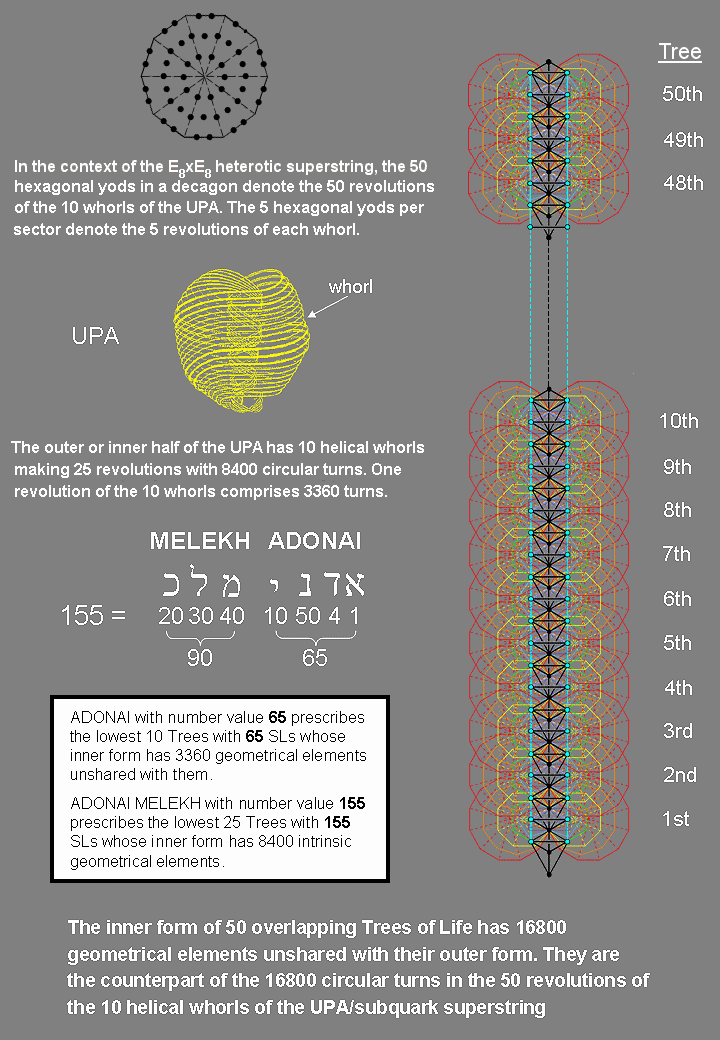
| << Previous 1... 35 36 [37] 38 39 ...50 Next >> |
How the Divine Name ELOHIM prescribes the structure and unified forces of the UPA/subquark superstring

As a symbol of the number 10, the decagon whose 10 sectors are tetractyses has 50 hexagonal yods. They manifest in the ten-fold UPA/E8×E8 heterotic superstring as the 50 revolutions of its 10 whorls, each whorl making five revolutions around its axis of spin, just as there are five hexagonal yods per sector. ELOHIM, the Godname of Binah with number value 50 (see here), prescribes how many revolutions the whorls make around the spin axis of the subquark superstring.
Each whorl is a helix with 1680 circular turns:
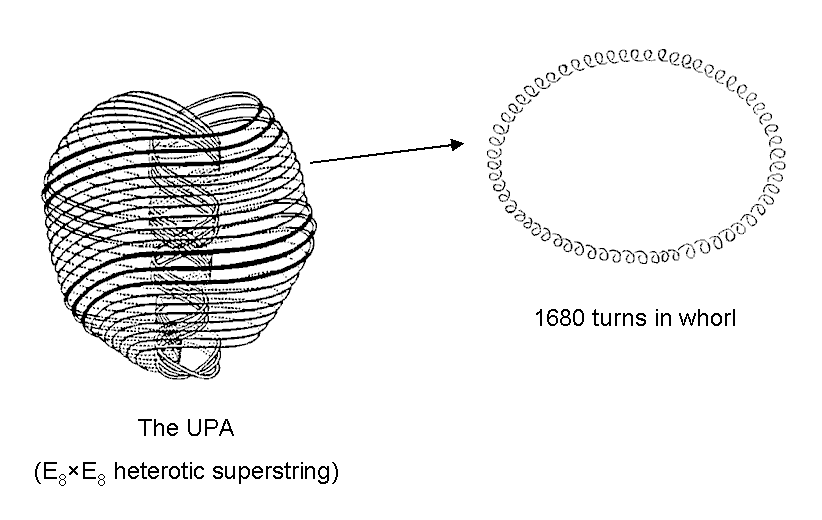
It winds 2½ times around the axis in an outer spiral that contains 840 turns and returns to the top of the UPA by winding 2½ times in an inner spiral composed of 840 turns. The outer half of the UPA consists of 10 separate whorls that wind 25 times around its axis, making 8400 turns. Its inner half consists of 8400 more turns in 25 revolutions. Each of the five revolutions of the set of 10 whorls consists of 3360 turns. An outer half-revolution of all 10 whorls contains 1680 turns, as does an inner half-revolution.
The (7+7) polygons enfolded in a single Tree of Life consist of 349 corners, sides & triangular sectors, i.e., 346 geometrical elements outside their root edge. The topmost corners of the two hexagons coincide with the lowest corners of the two hexagons enfolded in the next higher Tree. This means that the number of geometrical elements outside the root edges of the 14n polygons enfolded in n Trees = 344n + 2, the number "2" denoting the topmost corners of the two hexagons enfolded in the nth Tree. The corners of the two triangles coincide with Chesed and Geburah of each Tree and the vertical sides joining them to the top and lowest corners of the two hexagons coincide with Paths on the side pillars. These are also sides of triangles of each outer Tree. Hence (8n+2) corners & sides of the polygons enfolded in n Trees are shared with the latter. They are coloured green in the adjacent diagram. No triangular sectors are shared because none of the triangles in the Tree of Life lie in the plane of the 14 enfolded polygons. The number of geometrical elements outside the root edges of the 14n polygons that are unshared with the n Trees = 344n + 2 − 8n − 2 = 336n.
Suppose that each revolution of a whorl is represented by a Tree of Life. The 50 revolutions of the 10 whorls will then be represented by 50 Trees whose 700 enfolded polygons consist (outside their root edges) of (336×50=16800) intrinsic geometrical elements. This is the number of turns in the 10 helical whorls. Five Trees whose 70 enfolded polygons consist of (5×336=1680) intrinsic geometrical elements map the five revolutions of a whorl comprising 1680 turns. ADONAI, the Godname of Malkuth with number value 65, prescribes the lowest 10 Trees of Life with 65 SLs. This maps 10 revolutions made by two whorls comprising 3360 turns. ADONAI MELEKH, the complete Godname of this Sephirah with number value 155, prescribes the lowest 25 Trees because they have 155 SLs. This maps the 25 revolutions comprising 8400 turns made by all 10 whorls in the outer half of the UPA, the remaining set of 25 Trees mapping the 25 revolutions in its inner half comprising another 8400 turns. (It makes more sense, intuitively speaking, to identify the lowest 25 Trees with the 25 revolutions of the outer (rather than the inner) section of the UPA, although this identification is inessential to the present discussion). The geometrical composition intrinsic to the inner form of 50 Trees is the counterpart of the turns comprising 50 revolutions of the whorls of the UPA/subquark superstring. The oscillatory form of the subquark superstring conforms to the holistic geometry of the inner form of the archetypal set of 50 Trees of Life prescribed by ELOHIM, the Godname assigned to Binah, which is the third member of the Supernal Triad. ADONAI prescribes the number of turns (3360) per revolution in all 10 whorls and ADONAI MELEKH prescribes the number of turns (8400) in the 25 revolutions of the whorls in the outer half of the UPA.
As well as the (8n+2) shared geometrical elements, the n root edges of the (7+7) enfolded polygons enfolded in n Tree of Life consist of 3n points & lines. Hence, (11n+2) geometrical elements are either shared or belong to root edges. For n = 50, (11×50=550) such geometrical elements belong exclusively to the 700 enfolded polygons, the two top corners of the hexagons enfolded in the 50th Tree coinciding with the lowest corners of the two hexagons enfolded in the 51st Tree. The CTOL parameter 550 appears in the same context as the superstring structural parameter 16800. This is not surprising, for both numbers are parameters of holistic systems. The total number of geometrical elements that belong solely to the inner form of the lowest 50 Trees in CTOL = 550 + 16800. ELOHIM determines not only the number of revolutions in the whorls of the UPA but also their number of helical turns.
The prescription of the lowest 50 Trees by ELOHIM has another significance for the superstring. It is the Godname of Binah, and Binah of the 50th Tree is the 248th SL from the top of CTOL. We see that these 50 Trees determine not only the structure of the UPA/subquark superstring but also the dimension of the Lie group E8 that describes the symmetry of the unified forces between superstrings! YAHWEH, the Godname of Chokmah with number value 26, prescribes the 50 Trees because they have 101 SLs on each side pillar, where 101 is both the 26th prime number and the number value of Michael, the Archangel assigned to Tiphareth. It is one way in which this Godname prescribes the form of the subquark superstring in terms of the 16800 turns of its 10 whorls. Another way is that the quantum mechanics of bosonic strings requires space-time to possess 26 dimensions.
This correlation between the turns of the whorls of the UPA and the intrinsic geometrical composition of the polygons indicates that each revolution of a whorl is a whole mapped by a complete Tree of Life. ADONAI MELEKH divides the 50 revolutions prescribed by ELOHIM into two sets of 25, namely, the inner and outer halves of the UPA. This 25:25 division of the number 50 is a characteristic pattern of holistic systems — sacred geometries in particular. For example, the 50 vertices of the five Platonic solids can be divided into a set of 25 and a set of their mirror images (in the case of the tetrahedron, its four vertices consist of two pairs of vertices belonging to different edges). On average, there are 248 geometrical elements other than vertices in each half of the five Platonic solids that surround their axes (see here). Article 4 establishes that the Godnames of the 10 Sephiroth prescribe the first (6+6) enfolded polygons as a holistic subset of the set of (7+7) enfolded polygons making up the inner Tree of Life. They have 50 corners, 25 corners (red or black) being associated with each set:
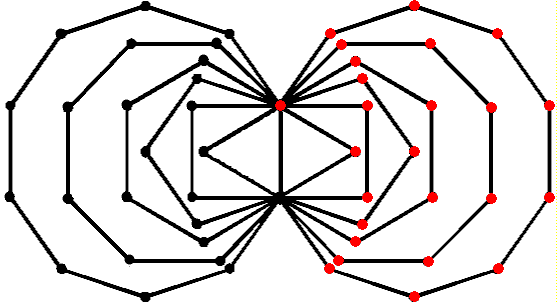
When their 70 sectors are tetractyses, they have 386 yods, that is, (386−50=336) coloured yods other than their 50 black & red corners, each set of the first six enfolded polygons with 35 tetractyses containing 168 such yods:
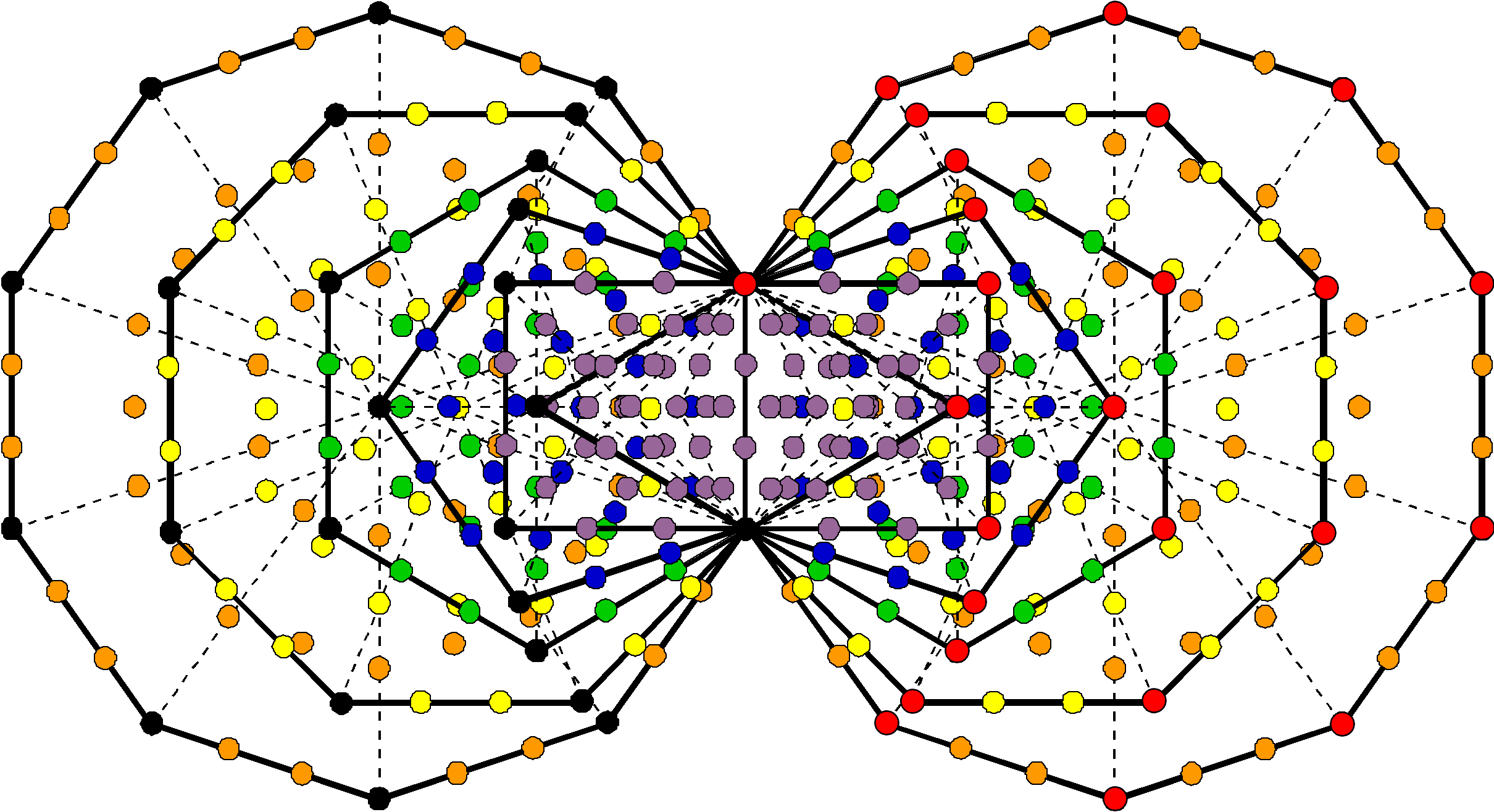
This is how this holistic subset of the 14 polygons prescribed by ELOHIM embodies the superstring structural parameter 336 — the number of turns in each revolution of a helical whorl. The first (6+6) polygons enfolded in every one of 50 overlapping Trees of Life have (50×336=16800) yods other than their 2400 corners (as the two uppermost corners of each pair of hexagons coincide with the lowest corners of the two hexagons in the next higher Tree, there are 48 corners per subset, making a total of (50×48=2400) intrinsic corners of the 600 polygons of the first six types). The 16800 yods other than corners of polygons denote the 16800 turns of the 10 whorls of the UPA. This is a remarkable demonstration of the Tree of Life basis of the UPA when the revolutions of its whorls are represented by Trees.
As shown in #35, the first (6+6) enfolded polygons also embody the 248 roots of E8 because 248 hexagonal yods outside the root edge that are unshared with the outer Tree line the sides of their 70 tetractyses. The 35:35 division of the 70 sectors of the first (6+6) enfolded polygons generates the 168:168 division of the number 336, namely, the 168 turns in an outer or inner half-revolution of a whorl of the UPA. We saw earlier that the 14n polygons enfolded in n Trees have 336n geometrical elements outside their root edges that are unshared with these Trees. This means that the inner form of successive Trees consists of 336 intrinsic geometrical elements outside the root edge, 168 such elements making up each set of seven enfolded polygons with 35 sectors. The counterpart of this pattern in the outer Tree of Life, which has 70 yods when its 16 triangles are tetractyses, is its division into the trunk composed of 35 yods and its branches composed of 35 yods (see here). Its counterpart in the 50 Trees of Life, whose inner form consists of 700 polygons with 16800 intrinsic geometrical elements outside root edges, is the set of 350 polygons enfolded on either side of the central Pillar of Equilibrium. The number 350 is another characteristic parameter of holistic systems, being the sum of the 20 integers making up the Tetrahedral Lambda, which is the arithmetic version of sacred geometry (see here). Each set of 350 polygons has 8400 intrinsic geometrical elements outside their root edges. This is the number of turns in the 25 revolutions in the outer or inner halves of the UPA. The two halves of the inner form of 50 Trees correspond to the two halves of the UPA. The outer half of the latter constitutes the "branches" of the microscopic Tree of Life and its core is the "trunk." We may regard the Tree of Life counterpart of the UPA either as the inner form of the lowest 25 Trees and the inner form of the next set of 25 Trees (as we considered earlier) or as the 350 polygons in one half of the inner form of 50 Trees and their mirror images in its other half.
As
84 = 12 + 32 + 52 + 72 = 22 + 42 + 82,
8400 = 84×102 = 102 + 302 + 502 + 702 = 202 + 402 + 802.
Therefore,
16800 = 8400 + 8400 = 102 + 202 + 302 + 402 + 502 + 702 + 802.
The 25:25 division of the number of ELOHIM, which determines the outer and inner halves of the UPA and the two halves of the inner form of 50 Trees of Life, has its arithmetic counterpart in the sum of the squares of the four numbers 10, 30, 50 & 70 and in the sum of the squares of the three numbers 20, 40 & 80. Apart from the common factor 102, the number 16800 is the sum of the squares of seven integers, the first four odd integers 1, 3, 5 & 7 determining the 8400 turns in the outer half of the UPA and the three even integers 2, 4 & 8 determining the 8400 turns in its inner half. This is a beautiful illustration of the Pythagorean insight that number underlies the form of material things. The number 50 of ELOHIM is itself the sum of three consecutive squares that divide into 25 and 25:
50 = (32 + 42) + 52 = 25 + 25.
Just as the trunk of a real tree is, essentially, a tapered cylinder out of which its branches project in the third dimension of space, so the trunk of the Tree of Life is the set of 25 points, lines & triangles (i.e., 0-, 1- & 2-dimensional geometrical elements) that make up the sequence: point→ line→ triangle→ tetrahedron:
| Trunk |
Point |
Line |
Triangle |
Tetrahedron |
| Point | 1 | 0 | 0 | 0 |
| Line | 2 | 1 | 0 | 0 |
| Triangle | 3 | 3 | 1 | 0 |
| Tetrahedron | 4 | 6 | 4 | 1 |
| Total | 10 | 10 | 5 | 1 |
whilst its branches (the remainder of the outer Tree) comprise 25 geometrical elements attached to this trunk that comprise 12 lines, 11 triangles & two tetrahedra with vertices located at Kether, Chokmah, Binah & Tiphareth and at Netzach, Hod, Yesod & Malkuth. The trunk and branches of the Tree of Life, therefore, consist of 50 geometrical elements. The respective counterparts in the UPA of the 25 points, lines & triangles in the trunk and the 25 lines, triangles & tetrahedra in the branches are the 25 revolutions of the 10 whorls in its outer half and their 25 revolutions in its inner half. The 25:25 division characteristic of holistic systems expresses this distinction between the core and branches of a tree. In the human skeleton, the distinction is the difference between the axial skeleton and the appendicular skeleton (see Article 33).
Another example of how ELOHIM prescribes the dimension 248 of E8 is purely arithmetic. This number is the arithmetic mean of the squares of the 25 successive integers 2, 3, .... 26:
248 = (22 + 32 + 42 +... + 262)/25,
showing how YAHWEH with number value 26 prescribes this number. Therefore, 24800 = 42 + 62 +... + 522, where
42 = 1 + 3 + 5 + 7,
62 = 1 + 3 + 5 + 7 + 9 + 11,
•
•
522 = 1 + 3 + 5 + ... + 103.
24800 is the sum of a triangular array of (4+6+...+52=700) odd integers with 25 1's as its base and 103 at its apex. Hence, 49600 is the sum of two such arrays. It contains 1400 odd integers with 50 1's as its base divided into two sets of 25 1's:
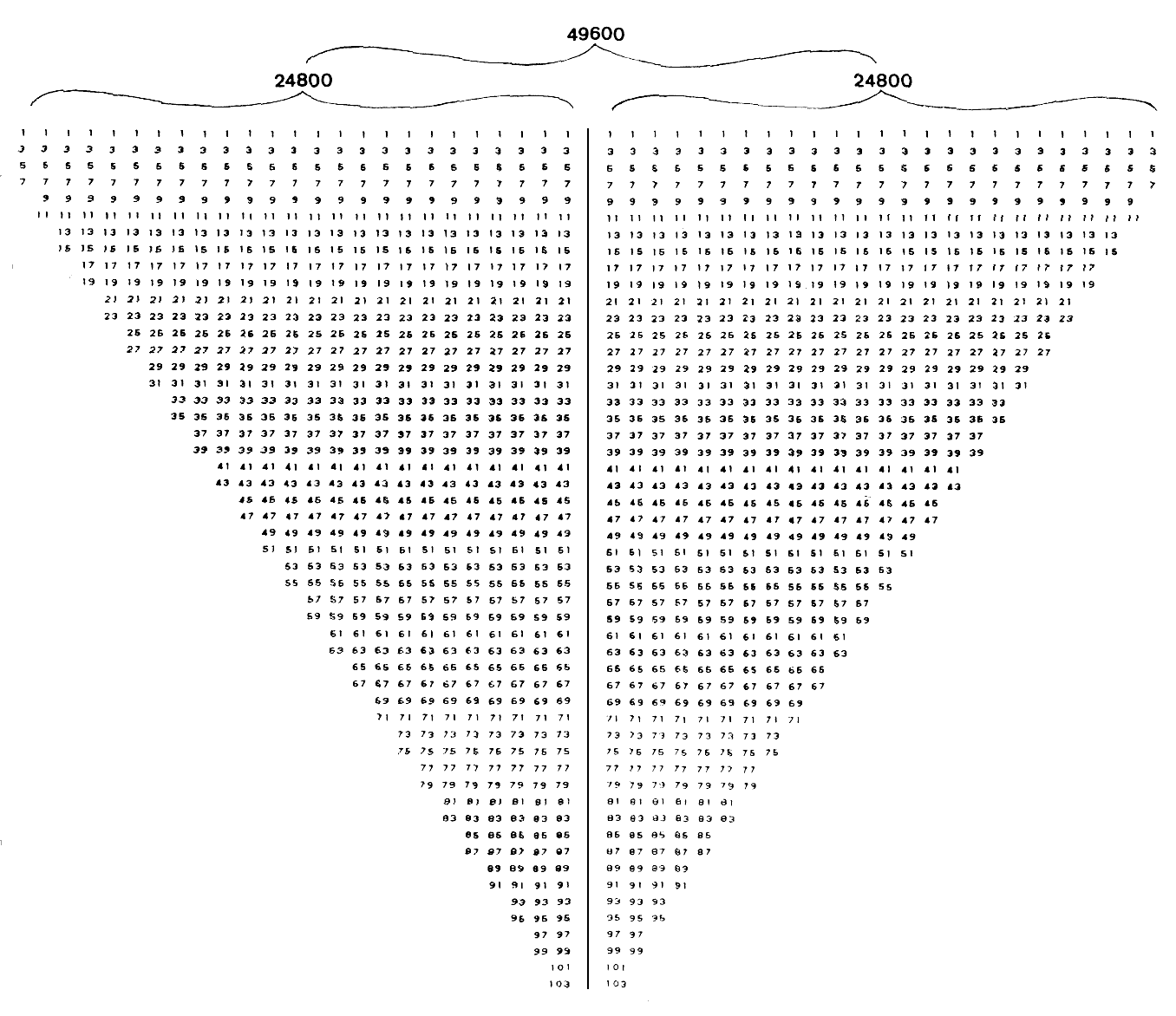
The number 103 at the apex of each array is the gematria number value of SABAOTH ("Hosts"), which is part of the Godname YAHWEH SABAOTH of Netzach and the Godname ELOHIM SABAOTH of Hod. The number 49600 can be represented by a 4×4 square array of the squares of 10, 30, 50 & 70:
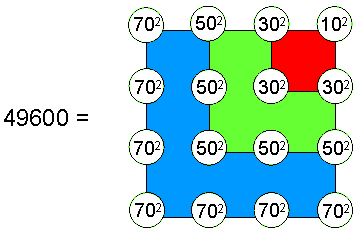
See also #5. This array with the pattern of the fourth square number 16 demonstrates how the Tetrad symbolized by the square determines the number 49600 through 10 (the fourth triangular number) and the first four odd integers 1, 3, 5 & 7. It is a simple illustration of the Tetrad Principle formulated in Article 1, which contains many examples of this principle at work in expressing group-theoretical (and other) parameters of superstrings and bosonic strings. Indeed, the sum of the four squared numbers on the right side of the square:
102 + 302 + 502 + 702 = 8400,
is the number of turns of the 10 helical whorls in the outer or inner halves of the UPA:
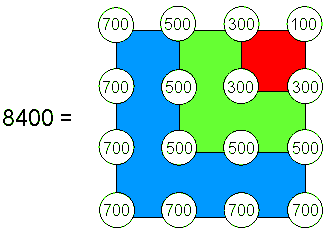
whilst a similar square pattern of the cubes of 1, 3, 5 & 7 generates the number 3108 as the number of points, lines & triangles in the Cosmic Tree of Life:
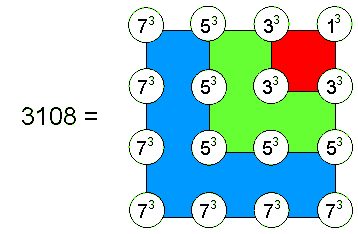
(See here). As 3108 = 14 + 34 + 54 + 74, this shows par excellence how the Tetrad expresses parameters of holistic systems, in this case the geometrical composition of CTOL. The sum of the first seven orders of non-trivial polygonal numbers (i.e., numbers larger than 1) corresponding to the seven regular polygons of the inner Tree of Life is
8
Σ (Tn + Sn + Pn + Hn + On + Dn + dn) = 3108.
n=2
In other words, the sum of these (7×7=49) polygonal numbers measures the geometrical composition of CTOL, showing how it is prescribed by EL ChAI, the Godname of Yesod with number value 49. See also comment 10 in the section 'Godname numbers' in Polygonal numbers.
In conclusion, the gematria number value of 50 of the Godname ELOHIM manifests in the subquark state of the E8×E8 heterotic superstring as the 50 revolutions of its 10 helical whorls. The counterparts of their 16800 circular turns in the inner form of the 50 overlapping Trees that represent these revolutions are:
1. the 16800 yods other than corners in the first six types of polygons that are enfolded in them;
2. the 16800 geometrical elements outside the root edges of the 700 polygons enfolded in these Trees that are unshared with the latter.
As 50 = 10×5 = 25×2, the two possible factorisations of this number express the two essential structural aspects of the subquark superstring, namely, 1. its 10-fold division into whorls. each of which winds five times around its axis of spin, and 2. its two halves, each comprising 25 revolutions of its 10 whorls. Given the facts that the trunk and branches of the Tree of Life, each with 25 geometrical elements and 35 yods, correspond, respectively, to the 25 corners associated with each set of the first six enfolded polygons and to the 35 corners associated with each set of the seven enfolded polygons, it is clear that the core of the UPA composed of 25 revolutions of its 10 whorls is the trunk of the microscopic Tree of Life and its heart-shaped exterior with 25 revolutions is its branches.
Any skeptic who argues that polygons and their properties have been cherry-picked here in order to generate the numbers 50, 1680, 3360 & 16800 characterizing the paranormal account of the UPA is forced to accept the ludicrous implication of his view, namely, that it is just by chance that:
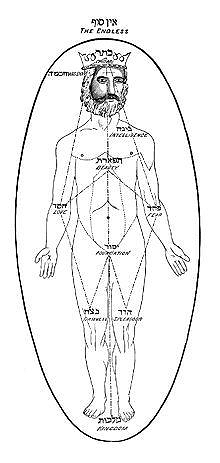 |
|
Adam Kadmon. |
In other words, the skeptic has to believe that every one of the many sacred-geometrical embodiments of UPA structure and superstring forces presented here and elsewhere on this website exists by accident and not because they are aspects of a universal, mathematical design which is implemented by the Divine Names through their gematria number values and which manifests not only in the Tree of Life but in the five Platonic solids, the Sri Yantra, the disdyakis triacontahedron, the 64 hexagrams, etc. The problem, of course, with this view is that it amounts to believing in a highly improbable concurrence of numerous miracles of chance. Why, therefore, should the skeptic regard his explanation as more rational than one which rejects coincidence because it is too implausible? Any reasonable person would regard such desperate embracing of unlikely coincidences as an irrational attempt by the skeptic to defend at all costs the presupposition by materialistic science that there is no grand, divine design behind the universe that explains why the sacred geometries of mystical traditions should embody both a paranormal account of matter given by Besant & Leadbeater and the scientific theory of superstrings. Highly improbable explanations do not become more acceptable simply because they conform better to scientific ideology. How can the latter virtue be so more important than being plausible that it trumps any religious explanation?! It can be so only to a zealot who does not care about whether his explanations are credible because his primary concern is to preserve the dogmas of scientism, which makes him willing to go to any extreme to achieve this. A healthy skepticism is essential to a scientist. Unfortunately, when faced with claims about the paranormal that they cannot refute in a plausible way, skeptics too often resort to far-fetched reasons to reject them because it is more important to them that they preserve the presuppositions of scientific orthodoxy than that they ascertain whether the claims are true irrespective of the ideological consequences of their conclusions. In the present context, the presupposition that the diehard skeptic defends is that God does not exist, so that a priori there cannot be any evidence of His design in the sacred geometries of religions. This means for the skeptic that any purported examples of divine design must be either concocted or illusions of coincidence. However, there are far too many such "illusions" for these possibilities to be credible, whilst the possession of analogous, mathematical patterns in sacred geometries demonstrated in The holistic pattern discredits the vacuous charge that their properties have been selected in an ad hoc way in order to create bogus evidence of divine design. These patterns are too many and too restrictive to leave enough freedom to make this possible, as is demonstrated by the constant appearance in these properties of the gematria numbers of the Godnames, the Archangels, Orders of Angels and Mundane Chakras of the 10 Sephiroth. This could not happen by chance every time some set of polygons with the required properties was — according to the skeptic — picked out so that it would exhibit features that matched the paranormal description of the UPA. The reason why it does happen is that such sets embody numbers that are characteristic parameters of holistic systems like the superstring remote-viewed by Besant & Leadbeater over a century ago. Being analogous representations of such systems, these sets necessarily display the gematria number values of the Sephiroth in the four Kabbalistic Worlds of Atziluth, Beriah, Yetzirah & Assiyah (see here), including even the numbers of their names. For this is what the numbers of these Hebrew words quantify, namely, "Adam Kadmon" (אדם קדמון), the divine prototype, conceived in the image of God. As this website reveals in abundance, amazing logical coherence, not random chance or fabrication, is what connects these numbers. This feature has no reasonable scientific or conventional explanation. The diehard skeptic knows that this is so, which is why he has to resort to far-fetched, alternative explanations like chance in order to avoid its implication prohibited by his philosophy, namely, that numbers and sacred geometry reveal the existence of a transcendental, designing Intelligence.